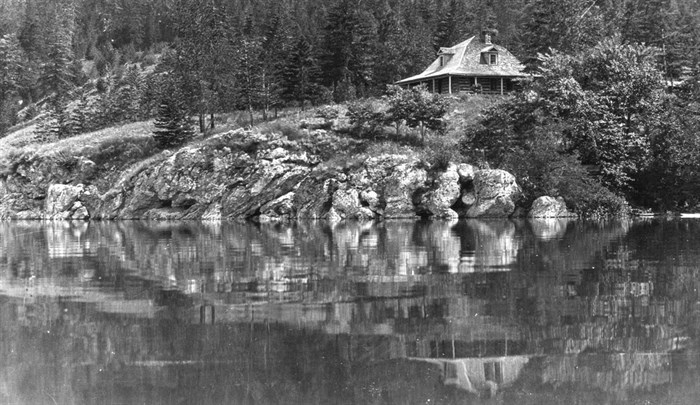
The Paul summer house.
Image Credit: FACEBOOK/You know you are from Kelowna B.C. if you remember.../Herb Tanaka
January 22, 2023 - 6:00 AM
There is a certain amount of mystery around why a remote but popular beach in Kelowna is called Paul’s Tomb.
Most people know a bit of the true story about the actual tomb being built by Rembler Paul back in 1910.
What is less well known, however, is that Rembler Paul tried to donate 125 acres of land there for a provincial university.
The province never took him up on that offer, nor on another one for a senior’s home on 160 acres or for the same land to be used for a home for injured soldiers from the First World War.
READ MORE: iN PHOTOS: Why tobacco failed to be the Okanagan's biggest crop
“Rembler and (his wife) Elizabeth loved gardening and kept great gardens at their properties including the site of the tomb,” their great, great granddaughter Lynda Doyle is reported to have written on what now seems to be a defunct version of the Friends of Knox Mountain Park website.
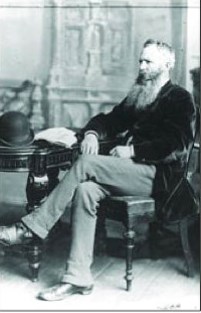
Rembler Paul.
Image Credit: Lynda Doyle
“It is said of Rembler that horses were his second love, family being the first,” Doyle wrote. “He is remembered for his many kind acts towards animals. People were also his concern. He played Santa. With a team of horses and wagon he would distribute Christmas hampers. Rembler, in his later years, wore a perfectly groomed full white beard, which would give him even more the appearance of Santa. Near the end of his life, he wanted to leave a tribute to his family in the form of the tomb.”
That reference is in ‘Isolated Burials in the Central Okanagan with Genealogies and Local History’ published in 2016 by historians Susan Campbell and Robert Hayes and is available online.
It goes into extensive details about the Paul family, citing old articles from the Kelowna Courier and Okanagan Orchardist newspaper and the 24th edition of the Okanagan Historical Society Annual Report, published in 1960.
It includes his obituary that appeared in the newspaper on Nov. 23, 1916.
“Although a man who had lived very much to himself, owing to his advanced age, yet amongst local residents he had gained an almost historic renown, chiefly on account of his strong personality and his financial interest in local business and property,” the obituary says.
Rembler Paul was born in Montreal in 1831 where his father was a veterinarian. At a young age he apprenticed as a printer.
READ MORE: Spiritualists, Japanese warlords and misspelled words: Where the Okunaakan got its names
“Finding the work too monotonous, however, and not at all to his taste, the young lad ran away from home and commenced a wandering career in the west, being one of the first white men to visit much of the country lying both east and west of the Rockies,” it read. “He was certainly of a roaming disposition and an adventurer in every sense of the word.
“After many years spent in prospecting, trapping and mining, he finally settled down in Regina, Sask., where he conducted a coal business for a number of years. While in Regina he bought large tracts of prairie land lying to the south of the city, which he afterwards sold to incoming farmers. It was in Regina that the greater part of his wealth was accumulated and it was from there he afterwards moved to Kelowna in 1905.”
There is another reference in the Isolated Burials publication about him being a veterinary surgeon in Moose Jaw before becoming a coal merchant with his son, Samuel, in Regina.
Rembler married Elizabeth Davis in Toronto (then called York) in 1853.
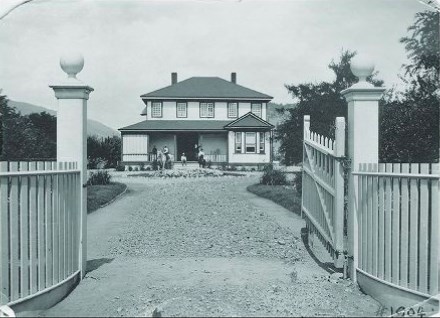
The Paul Home on Bernard Avenue.
Image Credit: Submitted/Isolated Burials in the Central Okanagan/Kelowna Public Archives
They retired to Kelowna in 1905 and lived on the north side of Bernard Avenue between St. Paul and Richter streets (somewhere around where the Bernard Block with its three highrise towers are now under construction).
St. Paul Street is believed to be named after his mine in Manitoba.
They had a summer home, where they spent considerable time, overlooking Okanagan Lake and the bay that is now known as Paul’s Tomb.
“While the summer home no longer exists, lilacs and irises from the garden continue to bloom each spring,” the Okanagan Historical Society report says.
A 1910 article reported that Rembler Paul offered the provincial government 125 acres of land on Knox Mountain as a free site for a provincial university, with a quarter mile of waterfront.
The province didn’t take him up on the offer.
READ MORE: The Kelowna police chief who murdered two people in broad daylight
In 1912, the newspaper reported that he made a presentation to Kelowna City Council with another offer.
“I am willing to give 160 acres, all fenced in, and erect a building that will hold about 15 to 20 people for a home for the aged and infirm for the valley for about 10 miles on each side of the lake from the head of the lake to the foot for the unfortunates that have lived in the valley for at least five years,” he proposed. “And, I will give a grant of $2,000 a year if the government will give a grant of $1,000 a year and exempt the place from taxes: that is, if the City of Kelowna will take the management of the house for the poor unfortunates.”
While council welcomed the offer and said they would approach the provincial government, nothing came of that effort either.
“PS: If the citizens do not take my offer, it will be the last I will make,” Rembler also wrote.
On June 5, 1914, Elizabeth died after a nine-year battle with cancer and was interred in the tomb he had built.
This description of the tomb was in the 24th edition of the Historical Society report and attributed to Gladys Herbert.
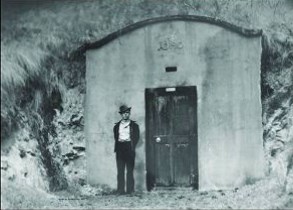
Paul's Tomb with unnamed man in front.
Image Credit: Kelowna Public Archives
“A vertical cut was made through this huge mound and an excavation made into the bank, creating a cave about 15 feet long, nine feet wide and seven feet high,” she wrote. “The ceiling was neatly rounded and the seven-foot measurement represents the height at the centre. The whole was lined with concrete. The floor and ceiling of the vault are 16 inches thick.
“There is a passageway down the centre with two concrete shelves on either side, extending the full length of the interior. These shelves are supported by cement pillars. Thus provision was made for eight coffins. The smoother face of the cave is a concrete wall, some nine feet wide and 10 feet high, arched at the top.
“A steel vault door was fitted into this cement façade, similar to the door of a walk-in bank vault. The Taylor Safe Works built the door and the combination lock. The area in front of the cave was levelled for some 24 feet to permit easy access to the tomb.”
In 1915, Rembler made another offer to city council, even though he said the retirement home would be his last. He felt, since that offer had been rejected, he was free to give the land, and the buildings he had subsequently erected on it, to another worthy cause.
This time, he offered the land and buildings “for the purpose of a home for the men disabled in the war.”
That, too, went nowhere.
In the fall of 1916, fearing pulmonary trouble, he travelled to Edmonton to spend the winter. He died there on Nov.18, 1916 and was returned to Kelowna to be interred in the tomb.
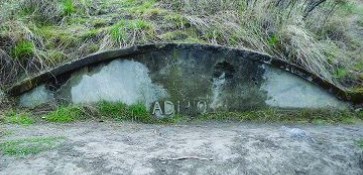
This photo was taken in 2012 and is all that was visible of the tomb.
Image Credit: Carolin Robertson
Only he and Elizabeth are buried there.
“For many years, Paul’s Tomb was very isolated and, therefore, prone to vandalism,” the Isolated Burials report says. “Numerous attempts were made to break into the tomb, all fortunately unsuccessful. The tomb was backfilled to prevent further damage.”
That work was done in the early 1970s with only the top, bearing the date A.D. 1910, still visible.
To contact a reporter for this story, email Rob Munro or call 250-808-0143 or email the editor. You can also submit photos, videos or news tips to the newsroom and be entered to win a monthly prize draw.
We welcome your comments and opinions on our stories but play nice. We won't censor or delete comments unless they contain off-topic statements or links, unnecessary vulgarity, false facts, spam or obviously fake profiles. If you have any concerns about what you see in comments, email the editor in the link above.
News from © iNFOnews, 2023